Chandrayaan-3
Chandrayaan-3 (/ˌtʃʌndrəˈjɑːn/ CHUN-drə-YAHN) is the third mission in the Chandrayaan programme, a series of lunar-exploration missions developed by the Indian Space Research Organisation (ISRO).[7] Launched on 14 July 2023, the mission consists of a lunar lander named Vikram and a lunar rover named Pragyan, similar to those launched aboard Chandrayaan-2 in 2019.
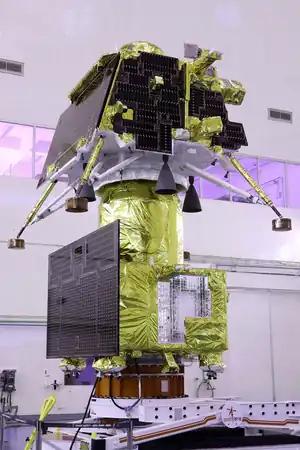 Chandrayaan-3 Integrated Module | |
| Mission type | |
|---|---|
| Operator | ISRO |
| COSPAR ID | 2023-098B |
| SATCAT no. | 57320 |
| Website | Official website |
| Mission duration | 3 months and 12 days (elapsed) (PM)
|
| Spacecraft properties | |
| Bus | Chandrayaan |
| Manufacturer | ISRO |
| Launch mass | 3900 kg[1] |
| Payload mass | Propulsion Module: 2148 kg Lander Module (Vikram): 1726 kg Rover (Pragyan) 26 kg Total: 3900 kg |
| Power | Propulsion Module: 758 W Lander Module: 738 W (WS with Bias) Rover: 50 W |
| Start of mission | |
| Launch date | 14 July 2023, 14:35:17 IST (09:05:17 UTC)[2] |
| Rocket | LVM3 M4 |
| Launch site | Satish Dhawan Space Centre |
| Contractor | ISRO |
| Moon orbiter | |
| Orbital insertion | 5 August 2023 |
| Orbital parameters | |
| Periselene altitude | 153 km (95 mi) |
| Aposelene altitude | 163 km (101 mi) |
| Moon lander | |
| Spacecraft component | Vikram lander |
| Landing date | 23 August 2023, 18:03 IST (12:33 UTC)[3] |
| Landing site | Shiv Shakti point
(between Manzinus C and Simpelius N craters)[5] |
| Moon rover | |
| Landing date | 23 August 2023 |
| Distance driven | 101.4 m (333 ft)[6] |
Mission Insignia | |
Chandrayaan-3 was launched from Satish Dhawan Space Centre on 14 July 2023. The spacecraft entered lunar orbit on 5 August, and the lander touched down near the Lunar south pole[8] on 23 August at 18:03 IST (12:33 UTC), making India the fourth country to successfully land on the Moon, and the first to do so near the lunar south pole.[9][note 1] On 3 September the lander hopped and repositioned itself 30–40 cm (12–16 in) from its landing site.[13] After the completion of its mission objectives, it was hoped that the lander and rover would revive for extra tasks, on 22 September 2023, but missed the wake-up call. On September 30, the second lunar night began, eliminating hopes of revival.[14][15]
Background
On 22 July 2019, ISRO launched Chandrayaan-2 on board a Launch Vehicle Mark-3 (LVM3) launch vehicle consisting of an orbiter, a lander and a rover.[16] The lander was scheduled to touch down on the lunar surface on 6 September 2019 to deploy the Pragyan rover. The lander lost contact with mission control, deviated from its intended trajectory while attempting to land near the lunar south pole, and crashed.[17][18]
The lunar south pole region holds particular interest for scientific exploration. Studies show large amounts of ice there. Mountainous terrain and unpredictable lighting protect the ice from melting, but they also make landing scientific probes there a challenging undertaking. The ice could contain solid-state compounds that would normally melt under warmer conditions elsewhere on the Moon—compounds which could provide insight into lunar, Earth, and Solar System history. For future crewed missions and outposts, ice could also be a source of drinking water and of hydrogen for fuel and oxygen.[19][20]
The European Space Tracking network (ESTRACK), operated by the European Space Agency (ESA), and Deep Space Network operated by Jet Propulsion Laboratory (JPL) of NASA are supporting the mission.[21] Under a new cross-support arrangement, ESA tracking support could be provided for upcoming ISRO missions such as those of India's first human spaceflight programme, Gaganyaan, and the Aditya-L1 solar research mission. In return, future ESA missions will receive similar support from ISRO's own tracking stations.[22]
Objectives
ISRO's mission objectives for the Chandrayaan-3 mission are:
- Engineering and implementing a lander to land safely and softly on the surface of the Moon.
- Observing and demonstrating the rover's driving capabilities on the Moon.
- Conducting and observing experiments on the materials available on the lunar surface to better understand the composition of the Moon.[23]
Spacecraft
Design
Chandrayaan-3 comprises three main components: a propulsion module, lander, and rover.
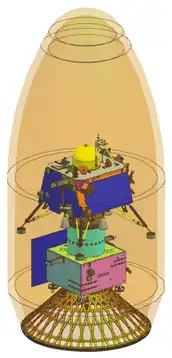 Chandrayaan-3 encapsulated within LVM3's payload fairing
Chandrayaan-3 encapsulated within LVM3's payload fairing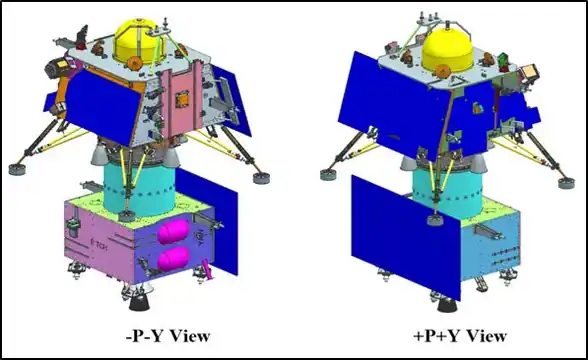 Chandrayaan-3 integrated components
Chandrayaan-3 integrated components
Propulsion module
The propulsion module carried the lander and rover configuration to a 100-kilometre (62 mi) lunar orbit. It was a box-like structure with a large solar panel mounted on one side and a cylindrical mounting structure for the lander (the Intermodular Adapter Cone) on top.[24][25]
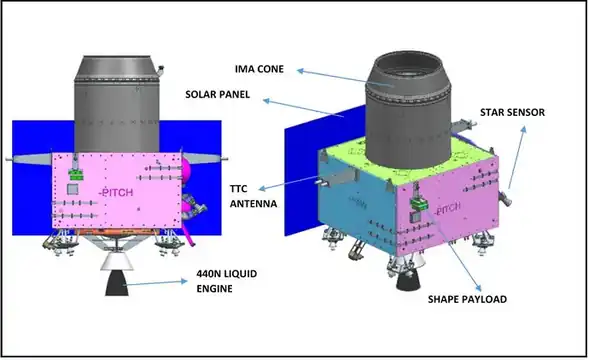 Propulsion module
Propulsion module
Vikram Lander
The Vikram lander was responsible for the soft landing on the Moon. It is also box-shaped, with four landing legs and four landing thrusters capable of producing 800 newtons of thrust each. It carried the rover and has various scientific instruments to perform on-site analysis.[26][27] The lander has four variable-thrust engines with slew rate changing capabilities, unlike Chandrayaan-2's lander, which had five, with the fifth one being centrally mounted and capable only of fixed thrust. One of the main reasons for Chandrayaan-2's landing failure was altitude increase during the camera coasting phase. This was removed by allowing the lander to control attitude and thrust during all phases of descent. Attitude correction rate was increased from Chandrayaan-2's 10°/s to 25°/s with Chandrayaan-3. Additionally, the Chandrayaan-3 lander is equipped with a laser Doppler velocimeter (LDV) to allow measuring altitude in three directions.[28][29] The impact legs were made stronger compared to Chandrayaan-2 and instrumentation redundancy was improved. It targeted a more precise 16 km2 (6.2 sq mi) landing region based on images provided by the Orbiter High-Resolution Camera (OHRC) onboard Chandrayaan-2's orbiter. ISRO improved the structural rigidity, increased polling in instruments, increased data frequency and transmission, and added additional multiple contingency systems to improve lander survivability in the event of failure during descent and landing.[30][29]
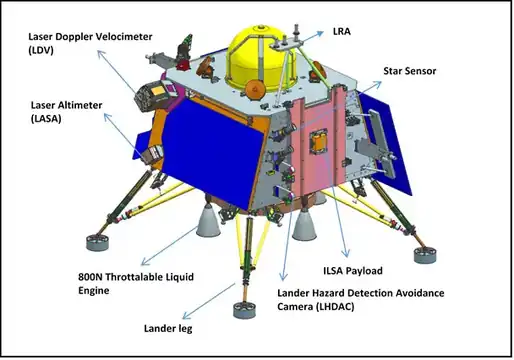 Lander
Lander
Rover
The Pragyan rover is a six-wheeled vehicle with a mass of 26 kilograms (57 pounds). It is 917 by 750 by 397 millimetres (36.1 in × 29.5 in × 15.6 in) in size.[31] The rover is expected to take multiple measurements to support research into the composition of the lunar surface, the presence of water ice in the lunar soil, the history of lunar impacts, and the evolution of the Moon's atmosphere.[32][8]
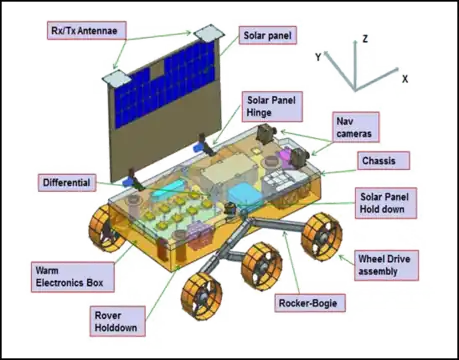 Pragyan rover
Pragyan rover
On lander
- Chandra's Surface Thermophysical Experiment (ChaSTE) will measure the thermal conductivity and temperature of the lunar surface.
- Instrument for Lunar Seismic Activity (ILSA) will measure the seismicity around the landing site.
- Langmuir Probe (LP) will estimate the near-surface plasma density over time.[33]
 Chandra's Surface Thermophysical Experiment (ChaSTE)
Chandra's Surface Thermophysical Experiment (ChaSTE)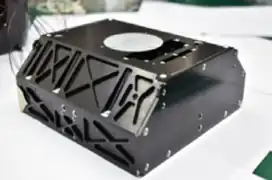 Instrument for Lunar Seismic Activity (ILSA)
Instrument for Lunar Seismic Activity (ILSA) Langmuir Probe (RAMBHA-LP)
Langmuir Probe (RAMBHA-LP)
On rover
- An alpha particle X-ray spectrometer (APXS) will derive the chemical composition and infer the mineralogical composition of the lunar surface.
- Laser-induced breakdown spectroscopy (LIBS) will determine the elemental composition (Mg, Al, Si, K, Ca, Ti, Fe) of lunar soil and rocks around the lunar landing site.[33]

 Laser-Induced Breakdown Spectroscope (LIBS)
Laser-Induced Breakdown Spectroscope (LIBS)
On the propulsion module
- Spectro-polarimetry of Habitable Planet Earth (SHAPE) will study spectral and polarimetric measurements of Earth from the lunar orbit in the near-infrared (NIR) wavelength range (1–1.7 μm).[24][25] Findings of SHAPE might aid in future exoplanet research and search for extraterrestrial life.[34]
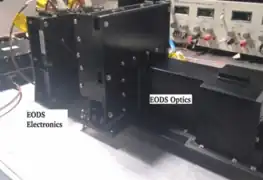 Spectro-polarimetry of Habitable Planet Earth (SHAPE)
Spectro-polarimetry of Habitable Planet Earth (SHAPE)
Mission profile

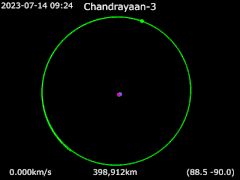
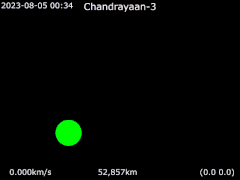
Launch
_of_SDSC-SHAR%252C_Sriharikota_03.webp.png.webp)
Chandrayaan-3 was launched aboard an LVM3-M4 rocket on 14 July 2023, at 09:05 UTC from Satish Dhawan Space Centre Second Launch Pad in Sriharikota, Andhra Pradesh, India, entering an Earth parking orbit with a perigee of 170 km (106 mi) and an apogee of 36,500 km (22,680 mi).
Orbit
After a series of Earth bound manoeuvres that placed Chandrayaan-3 in a trans-lunar injection orbit,[35][36][37] ISRO performed a lunar-orbit insertion (LOI) on 5 August, successfully placing the Chandrayaan-3 spacecraft into an orbit around the Moon. The LOI operation was carried out from the ISRO Telemetry, Tracking, and Command Network (ISTRAC) in Bengaluru.[38][39]
On 17 August, the Vikram lander separated from the propulsion module to begin the last phase of the mission.[40]
Landing

.webp.png.webp)

On 23 August 2023, as the lander approached the low point of its orbit, its four engines fired as a braking manoeuvre at 30 kilometres (19 mi) above the Moon's surface. After 11.5 minutes, the lander was 7.2 km (4.5 miles) above the surface; it maintained this altitude for about 10 seconds, then stabilized itself using eight smaller thrusters and rotated from a horizontal to a vertical position while continuing its descent.
It then used two of its four engines to slow its descent to roughly 150 metres (490 ft); it hovered there for about 30 seconds and located an optimal landing spot before continuing downward and touching down at 12:33 UTC.[26][41]
| Stage and sequence | Date/ Time (UTC) |
LAM burn time | Orbit | Orbital period | References |
|---|---|---|---|---|---|
| Earth orbit: Launch | 14 July 2023 | — | 170 km × 36,500 km (110 mi × 22,680 mi) | — | |
| Earth bound maneuvers: 1 | 15 July 2023 | — | 173 km × 41,762 km (107 mi × 25,950 mi) | — | [42][43] |
| Earth bound maneuvers: 2 | 17 July 2023 | — | 226 km × 41,603 km (140 mi × 25,851 mi) | — | [42][44] |
| Earth bound maneuvers: 3 | 18 July 2023 | — | 228 km × 51,400 km (142 mi × 31,938 mi) | — | [45] |
| Earth bound maneuvers: 4 | 20 July 2023 | — | 233 km × 71,351 km (145 mi × 44,335 mi) | — | [42][46] |
| Earth bound maneuvers: 5 | 25 July 2023 | — | 236 km × 127,603 km (147 mi × 79,289 mi) | — | [47] |
| Trans-lunar injection | 31 July 2023 | — | 288 km × 369,328 km (179 mi × 229,490 mi) | — | [48] |
| Lunar bound maneuvers:1 (Lunar orbit insertion) | 5 August 2023 | 1,835 s (30.58 min) | 164 km × 18,074 km (102 mi × 11,231 mi) | Approx. 21 h (1,300 min) | [49] |
| Lunar bound maneuvers: 2 | 6 August 2023 | — | 170 km × 4,313 km (106 mi × 2,680 mi) | — | [50] |
| Lunar bound maneuvers:3 | 9 August 2023 | — | 174 km × 1,437 km (108 mi × 893 mi) | — | [51] |
| Lunar bound maneuvers:4 | 14 August 2023 | — | 150 km × 177 km (93 mi × 110 mi) | — | [52] |
| Lunar bound maneuvers:5 | 16 August 2023 | — | 153 km × 163 km (95 mi × 101 mi) | — | [53] |
| Lander deorbit maneuvers: 1 | 18 August 2023 | — | 113 km × 157 km (70 mi × 98 mi) | — | [54] |
| Lander deorbit maneuvers: 2 | 19 August 2023 | 60 s (1.0 min) | 25 km × 134 km (16 mi × 83 mi) | — | [55] |
| Landing | 23 August 2023 | TBC | — | — | [3] |
| Rover deployment | 23 August 2023 | — | — | — | [3] |
- The Moon photographed by the Lander Position Detection Camera (LPDC) aboard Chandrayaan-3 lander on 15 August 2023
- View from the Lander Imager Camera-1 (LI-1) on 17 August 2023 just after the separation of the Chandrayaan-3 Lander Module from the Propulsion Module
 Chandrayaan-3 orbital manoeuvre
Chandrayaan-3 orbital manoeuvre
Surface operations

On 3 September, the rover was put into sleep mode after it had completed all of its assignments. Its batteries were charged and receiver left on, according to ISRO, in preparation for the impending lunar night.[56] "The rover's payloads are turned off and the data it collected has been transmitted to Earth via the lander", the statement said. Chandrayaan-3's lander and rover were expected to operate only for one lunar daylight period, or 14 Earth days, and the on-board electronics were not designed to withstand the −120 °C (−184 °F) nighttime temperatures on the Moon.[57] On 22 September, the lander and rover missed their wake-up calls,[58][59] and by 28 September neither had responded, diminishing hopes for further surface operations.[60]
Hop experiment
Vikram fired its engines for a brief 'hop' on the lunar surface on 3 September, ascending 40 cm (16 in) off the lunar surface and translating a similar distance laterally across the surface.[61] The test demonstrated capabilities to be used in potential future sample return missions. The instruments and rover deployment ramp were retracted for the hop and redeployed afterwards.[62][63][64]
Team
- ISRO chairman: S. Somanath[66]
- Mission Director: S. Mohanakumar[67]
- Associate Mission Director: G. Narayanan[68]
- Project Director: P. Veeramuthuvel[69]
- Associate Project Director: Kalpana Kalahasti[70]
- Vehicle Director: Biju C. Thomas[71]
Funding
In December 2019, ISRO requested the initial funding of the project, amounting to ₹75 crore (US$9.4 million), out of which ₹600 million (US$7.5 million) would be for meeting expenditure towards machinery, equipment, and other capital expenditure, while the remaining ₹150 million (US$1.9 million) was sought for operating expenditure.[72] Amit Sharma, CEO of an ISRO vendor, said, "With local sourcing of equipment and design elements, we are able to reduce the price considerably."[73]
Confirming the existence of the project, ISRO's former chairman K. Sivan stated that the estimated cost would be around ₹615 crore (equivalent to ₹724 crore or US$91 million in 2023).[74][75][76]
Results
The Associated Press, while commenting on the success of the mission, said, "The successful mission showcases India's rising standing as a technology and space powerhouse and dovetails with Prime Minister Narendra Modi's desire to project an image of an ascendant country asserting its place among the global elite."[77]
Temperature variation
ISRO also released data from the observations made by ChaSTE (Chandra's Surface Thermophysical Experiment), one of the four instruments present on the lander module. ChaSTE was designed to study the heat conductivity of the Moon's surface and measure the differences in temperatures at different points on and below the surface, with the overall objective of creating a thermal profile of the Moon.

ISRO scientist BH Darukesha said the high range of 70-degree-Celsius (158-degree-Fahrenheit) temperature near the surface was "not expected".[78]
Detection of sulfur
On 29 August, ISRO reported that the laser-induced breakdown spectroscope (LIBS) instrument onboard the Pragyan rover has "unambiguously" confirmed the presence of sulfur in the lunar surface near the south pole, through "first-ever in-situ measurements".[79][80] The presence of sulfur on the Moon has been known before;[81] however, it was detected for the first time at the south pole by the rover.[82]
Noah Petro, a project scientist at NASA, while speaking to the BBC, stated that while sulfur has been known to be in the lunar regolith from Apollo program samples, he described Pragyan's findings as a "tremendous accomplishment".[83]
Apart from sulfur, the rover also detected other elements including aluminium (Al), calcium (Ca), iron (Fe), chromium (Cr), titanium (Ti), manganese (Mn), silicon (Si), and oxygen (O).[84] The agency said it is also searching for hydrogen (H).[85][86]

Plasma measurement
On 31 August, ISRO released plasma density data from the RAMBHA Instrument aboard the Vikram lander. Initial assessments reported relatively low plasma densities above the lunar surface varying from 5 to 30 million electrons per m3. The evaluation pertains to early stages of the lunar day. The probe aims to explore the changes in the near-surface plasma environment throughout the duration of the lunar day.[87]
Seismic measurements
On the same day, ISRO released data from the ILSA payload on the lander, providing vibration measurements of the rover movement on 25 August, and a presumed natural event on 26 August. The cause of the latter event is a subject of investigation,[88] it is suspected to be a moonquake.[86]
Domestic reactions
Chandrayaan-3's landing live stream on ISRO's official YouTube channel received eight million concurrent viewers,[89] which is the highest in YouTube's history.[90][91]
Congratulating the ISRO team behind the successful Chandrayaan-3 mission at ISRO Telemetry, Tracking and Command Network in Bengaluru, Prime Minister Narendra Modi announced that the touchdown point of the Vikram lander would henceforth be known as Shiv Shakti point.[92] He further declared 23 August, the day the Vikram lander landed on the Moon, as National Space Day.[93][94]
ISRO chief S. Somanath exclaimed "India is on the Moon" after the successful touchdown.[95] "We learnt a lot from our failure and corrected it. It's now 14 days of work and we have to conduct experiments," he told India Today.[96]
P Veeramuthuvel, the Project Director of the mission said, "It's a great moment of happiness. On behalf of the team it gives me immense satisfaction on achieving this goal as the Project Director of the mission. The entire mission operations right from launch till landing happened flawlessly as per the timeline".[97] S. Mohana Kumar, the Mission Director, said that Chandrayaan-3 was a "team effort".[98]
Meanwhile, former ISRO chief K Sivan, under whose tenure the Chandrayaan-2 was launched said, "We are really excited to see this grand success. For this, we have been waiting for the last four years. This success is sweet news for us and for the entire nation."[99]
Rahul Gandhi, the leader of the opposition, also celebrated Chandrayaan-3's success, calling it a result of "tremendous ingenuity and hard work" by the country's scientific community. "Since 1962, India's space program has continued to scale new heights and inspire generations of young dreamers," he posted on X.[100]
Delhi Chief Minister Arvind Kejriwal too, congratulated the scientists of ISRO on the successful landing and termed it a "historic" moment. "This is historical. It's a significant achievement for the country. It's a matter of pride for all of us. The success of Chandrayaan-3 is a result of the hard work of all citizens, ISRO scientists, engineers, and employees. Congratulations to everyone involved. Bharat Mata ki jai.", he posted on X.[101]
DY Chandrachud, the Chief Justice of India hailed the landing as "a milestone in the onward march of our nation" and congratulated the ISRO team.[102]
International reactions
Josef Aschbacher, Director General of European Space Agency, said: "Incredible! Congratulations to ISRO, Chandrayaan-3, and to all the people of India!! What a way to demonstrate new technologies AND achieve India’s first soft landing on another celestial body. Well done, I am thoroughly impressed."[103] [104][105]
Foreign Minister of Maldives, Abdulla Shahid tweeted: "As a South Asian nation, and neighbour, we are proud of the successful landing of Chandrayaan 3 near the moon's south pole. This is a success for all of humanity! Opening new avenues for new areas of exploration."[106]
NASA Administrator Bill Nelson tweeted: "Congratulations ISRO on your successful Chandrayaan-3 lunar South Pole landing and congratulations to India on being the 4th country to successfully soft-land a spacecraft on the Moon. We’re glad to be your partner on this mission".[107][108]
Cyril Ramaphosa, the President of South Africa said: "This for us, as the BRICS family, is a momentous occasion and we rejoice with you. We join you in the joy of this great achievement."[109]
Kremlin quoted Russian President Putin's message to Indian President Droupadi Murmu and Prime Minister Narendra Modi, "Please, accept my heartfelt congratulations on the occasion of the successful landing of the Indian space station Chandrayaan-3 on the Moon near its South Pole. This is a big step forward in space exploration and certainly a testament to the impressive progress made by India in the area of science and technology”. [110]
Nepal PM Pushpa Kamal Dahal said on X (formerly known as Twitter): "I congratulate Prime Minister Shri Narendra Modi ji and ISRO team of India on successful landing of Chandrayan-3 in the surface of the moon today and unleashing of a historic achievement in science and space technology."[111]
See also
- Aditya-L1 – Indian solar observation mission
- Gaganyaan – Indian crewed spacecraft project
- Indian Human Spaceflight Programme
- Indian Martian Exploration Programme
- Venus Orbiter Mission – Indian Venus exploration mission
Notes
References
- "Chandrayaan-3 vs Russia's Luna-25 | Which one is likely to win the space race". cnbctv18.com. 14 August 2023. Archived from the original on 16 August 2023. Retrieved 16 August 2023.
- "Chandrayaan-3". www.isro.gov.in. Archived from the original on 10 July 2023. Retrieved 14 July 2023.
- Jones, Andrew (23 August 2023). "Chandrayaan-3: India becomes fourth country to land on the moon". SpaceNews.com. Archived from the original on 23 August 2023. Retrieved 23 August 2023.
- "LVM3-M4 Gallery". Indian Space Research Organisation. Archived from the original on 28 August 2023. Retrieved 28 August 2023.
- "India launches Chandrayaan-3 mission to the lunar surface". Physicsworld. 14 July 2023. Archived from the original on 17 July 2023. Retrieved 15 July 2023.
- @isro (2 September 2023). "Chandrayaan-3 Mission" (Tweet). Retrieved 2 September 2023 – via Twitter.
- Kumar, Hari; Travelli, Alex; Mashal, Mujib; Chang, Kenneth (23 August 2023). "India Moon Landing: In Latest Moon Race, India Lands First in Southern Polar Region". The New York Times. ISSN 0362-4331. Archived from the original on 26 August 2023. Retrieved 26 August 2023.
- Sharmila Kuthunur (23 August 2023). "India on the moon! Chandrayaan-3 becomes 1st probe to land near lunar south pole". Space.com. Archived from the original on 23 August 2023. Retrieved 23 August 2023.
- Kumar, Sanjay (23 August 2023). "India makes history by landing spacecraft near Moon's south pole". Science.org. Archived from the original on 24 August 2023. Retrieved 24 August 2023.
- "Chandrayaan-3 launch on 14 July, lunar landing on 23 or 24 August". The Hindu. 6 July 2023. ISSN 0971-751X. Archived from the original on 11 July 2023. Retrieved 14 July 2023.
- "India lands spacecraft near south pole of moon in historic first". The Guardian. Archived from the original on 23 August 2023. Retrieved 23 August 2023.
- Karanam, Durga Prasad; Bhatt, Megha; A, Amitabh; G, Ambily; Sathyan, Sachana; Misra, Dibyendu; Srivastava, Neeraj; Bhardwaj, Anil (3 August 2023). "Contextual Characterisation Study of Chandrayaan-3 Primary Landing Site". Monthly Notices of the Royal Astronomical Society: Letters. doi:10.1093/mnrasl/slad106. ISSN 1745-3925. Archived from the original on 17 September 2023. Retrieved 5 September 2023.
- "Vikram lander's sudden hop on the Moon: Why it's a big deal". India Today. Archived from the original on 4 September 2023. Retrieved 6 September 2023.
- "No 2nd innings, 'super over' for Chandrayaan-3, but Vikram & Pragyan had a great outing". The Times of India. 4 October 2023. ISSN 0971-8257. Retrieved 10 October 2023.
- "Chandrayaan-3 goes dark again? Former ISRO chief says 'no hope of reviving' Vikram lander & Pragyan rover". The Indian Express. 7 October 2023. Retrieved 10 October 2023.
- "Chandrayaan-2: India launches second Moon mission". BBC News. 21 July 2019. Archived from the original on 22 August 2019. Retrieved 25 August 2023.
- "India has found its Vikram lander after it crashed into the moon's surface". MIT Technology Review. Archived from the original on 11 April 2023. Retrieved 25 August 2023.
- Chang, Kenneth (10 September 2019). "Did India's Chandrayaan-2 Moon Lander Survive? The Chances Are Slim". The New York Times. ISSN 0362-4331. Archived from the original on 11 September 2019. Retrieved 25 August 2023.
- Mahoney, Erin (17 August 2022). "Moon's South Pole is Full of Mystery, Science, Intrigue". NASA. Archived from the original on 23 August 2023. Retrieved 24 August 2023.
- "Explainer: Why are countries racing to the moon's heavily cratered south pole?". Reuters. 23 August 2023. Archived from the original on 24 August 2023. Retrieved 24 August 2023.
- "Chandrayaan-3 How NASA, ESA will support ISRO during the Moon landing on August 23". Archived from the original on 25 August 2023. Retrieved 30 August 2023..
- "ESA and Indian space agency ISRO agree on future cooperation". www.esa.int. Archived from the original on 21 March 2022. Retrieved 16 April 2022.
- "Chandrayaan-3 Details". Indian Space Research Organisation. Archived from the original on 23 August 2023. Retrieved 24 August 2023.
- "NASA – NSSDCA – Spacecraft – Details". Archived from the original on 8 June 2022. Retrieved 10 June 2022.
- "Chandrayaan-3 to cost Rs 615 crore, launch could stretch to 2021". The Times of India. 2 January 2020. Archived from the original on 19 November 2021. Retrieved 3 January 2020.
- Mehta, Jatan. "Chandrayaan-3 Makes Historic Touchdown on the Moon". Scientific American. Archived from the original on 24 August 2023. Retrieved 23 August 2023.
- "Chandrayaan-3 in its last leg of journey to moon". India Today. Archived from the original on 21 August 2023. Retrieved 23 August 2023.
- Kumar, Chethan (19 November 2019). "Chandrayaan-3 plans indicate failures in Chandrayaan-2". The Times of India. Archived from the original on 21 November 2019. Retrieved 15 September 2020.
- After 4 Years, ISRO Reveals Why Chandrayaan 2 FAILED, archived from the original on 10 August 2023, retrieved 10 August 2023
- Sharma, Shaurya (21 October 2022). "Chandrayaan-3 To Be More Robust, Have Contingency Systems Onboard, Says ISRO Chief". News18. Archived from the original on 22 October 2022. Retrieved 22 October 2022.
- "NASA – NSSDCA – Spacecraft – Details". nssdc.gsfc.nasa.gov. Archived from the original on 8 June 2022. Retrieved 23 August 2023.
- Livemint (16 August 2023). "Chandrayaan-3 highlights: Lander Vikram will be 30 km away from Moon today". mint. Archived from the original on 19 August 2023. Retrieved 23 August 2023.
- "ISRO Chandrayaan 3 brochure" (PDF). Archived from the original (PDF) on 10 July 2023. Retrieved 14 July 2023.
- "NASA - NSSDCA - Experiment - Details". nssdc.gsfc.nasa.gov. Retrieved 22 September 2023.
- "India's Chandrayaan-3 moon mission takes off with a successful launch as rocket hoists lunar lander and rover – CBS News". www.cbsnews.com. 14 July 2023. Archived from the original on 22 August 2023. Retrieved 23 August 2023.
- "India launches its Chandrayaan-3 Moon landing mission". SpaceFlight Insider. 14 July 2023. Archived from the original on 17 August 2023. Retrieved 23 August 2023.
- "Chandrayaan-3 update: Isro to fire up engines, put spacecraft on road to moon". India Today. Archived from the original on 1 August 2023. Retrieved 23 August 2023.
- THE HINDU BUREAU (5 August 2023). "Chandrayaan-3 spacecraft enters lunar orbit". The Hindu. Archived from the original on 6 August 2023. Retrieved 6 August 2023.
- Grey, Charles (6 August 2023). "India's Chandrayaan-3 Successfully Inserted Into Lunar Orbit". AIR SPACE News. Archived from the original on 6 August 2023. Retrieved 6 August 2023.
- "Chandrayaan-3: Indian lunar lander Vikram inches closer to Moon". BBC News. 17 August 2023. Archived from the original on 23 August 2023. Retrieved 23 August 2023.
- "India Is on the Moon: Lander's Success Moves Nation to Next Space Chapter". The New York Times. 23 August 2023. Archived from the original on 23 August 2023. Retrieved 23 August 2023.
- "Chandrayaan-3". ISRO. Archived from the original on 10 July 2023. Retrieved 14 July 2023.
- @isro (15 July 2023). "The first orbit raising operation" (Tweet). Retrieved 15 July 2023 – via Twitter.
- @isro (17 July 2023). "The second orbit raising operation" (Tweet). Retrieved 17 July 2023 – via Twitter.
- @isro (18 July 2023). "The third orbit raising operation" (Tweet). Retrieved 18 July 2023 – via Twitter.
- @isro (20 July 2023). "The fourth orbit raising operation" (Tweet). Retrieved 20 July 2023 – via Twitter.
- @isro (25 July 2023). "The fifth orbit raising operation" (Tweet). Retrieved 25 July 2023 – via Twitter.
- @isro (1 August 2023). "Chandrayaan-3 update" (Tweet). Retrieved 5 August 2023 – via Twitter.
- @isro (4 August 2023). "Lunar Orbit Injection (LOI)" (Tweet). Retrieved 5 August 2023 – via Twitter.
- @isro (6 August 2023). "Chandrayaan-3 Mission" (Tweet). Retrieved 6 August 2023 – via Twitter.
- @isro (9 August 2023). "Chandrayaan-3 Mission" (Tweet). Retrieved 9 August 2023 – via Twitter.
- @isro (14 August 2023). "Chandrayaan-3 Mission" (Tweet). Retrieved 14 August 2023 – via Twitter.
- @isro (16 August 2023). "Chandrayaan-3 Mission" (Tweet). Retrieved 16 August 2023 – via Twitter.
- @isro (18 August 2023). "Chandrayaan-3 Mission" (Tweet). Retrieved 18 August 2023 – via Twitter.
- @isro (19 August 2023). "Chandrayaan 3 mission: second and final deorbiting operation" (Tweet) – via Twitter.
- Chaturvedi, Arpan (3 September 2023). "Mission accomplished, India puts moon rover to 'sleep'". Reuters. Archived from the original on 17 September 2023. Retrieved 3 September 2023.
- "India's moon rover completes its walk, scientists analysing data looking for signs of frozen water". The Economic Times. 3 September 2023. ISSN 0013-0389. Archived from the original on 17 September 2023. Retrieved 3 September 2023.
- "India struggles to wake up Vikram Moon lander and Pragyan rover on lunar mission". Australian Broadcasting Corporation.
- "India's Moon Lander Misses Wake-Up Call After Successful Mission". The New York Times.
- "ISRO's Chandrayaan-3 does not wake up as hope dims for Vikram and Pragyan". The Indian Express. 26 September 2023. Retrieved 28 September 2023.
- "Chandrayaan-3 lander Vikram comes up with a surprise, makes a 'jump' on the Moon". The Indian Express. 4 September 2023. Retrieved 3 October 2023.
- ISRO [@isro] (4 September 2023). "Vikram Lander exceeded its mission objectives. It successfully underwent a hop experiment. On command, it fired the engines, elevated itself by about 40 cm as expected and landed safely at a distance of 30 – 40 cm away. Importance?: This 'kick-start' enthuses future sample return and human missions! All systems performed nominally and are healthy. Deployed Ramp, ChaSTE and ILSA were folded back and redeployed successfully after the experiment" (Tweet) – via Twitter.
- "Vikram lander's sudden hop on the Moon: Why it's a big deal". India Today. Archived from the original on 4 September 2023. Retrieved 13 September 2023.
- "India's Chandrayaan-3 lunar lander successfully 'hops' on the moon". Sky News. Archived from the original on 5 September 2023. Retrieved 13 September 2023.
- "Chandrayaan-3 Brochure" (PDF). Indian Space Research Organisation. Archived (PDF) from the original on 10 July 2023.
- "Chandrayaan-3 just 1k-km from lunar surface". The Times of India. 11 August 2023. ISSN 0971-8257. Archived from the original on 12 August 2023. Retrieved 12 August 2023.
- "With Chandrayaan-3 set to land today, meet key scientists behind ISRO moon mission". The Indian Express. 23 August 2023. Archived from the original on 24 August 2023. Retrieved 23 August 2023.
- Nirvaan (4 August 2023). "Chandrayaan 3 Price, Budget, Cost, (Orbiter, Lander, and Rover)". PM Sarkari Yojana Hindi. Archived from the original on 24 August 2023. Retrieved 23 August 2023.
- "Chandrayaan-3 | Not just sons of Tamil Nadu but State's soil itself contributed to Moon mission". The Hindu. 23 August 2023. ISSN 0971-751X. Retrieved 23 August 2023.
- "The making of Chandrayaan-3: collaborative effort under the 'ISRO culture'". www.isro.gov.in. Retrieved 24 September 2023.
- "Chandrayaan 3 Launch Live: India's Chandrayaan-3 moon mission lifts off from Sriharikota". The Times of India. 14 July 2023. Archived from the original on 17 July 2023. Retrieved 14 July 2023.
- Kumar, Chethan (8 December 2019). "ISRO seeks 75 crore more from Centre for Chandrayaan-3". The Times of India. Archived from the original on 20 January 2021. Retrieved 8 December 2019.
- Bhattacharjee, Nivedita (24 August 2023). "Chandrayaan-3 punches home India's lead in budget space flights". Reuters. Archived from the original on 26 August 2023. Retrieved 26 August 2023.
- "Chandrayaan-3 to cost Rs 615 crore, launch could stretch to 2021". The Times of India. 2 January 2020. Archived from the original on 30 December 2020. Retrieved 3 January 2020.
- "How much did India's Chandrayaan-3 lunar mission cost?". CNBC. 15 July 2023. Archived from the original on 17 July 2023. Retrieved 15 July 2023.
- Mike Wall (18 August 2023). "India's Chandrayaan-3 snaps close-up photos of moon ahead of landing try (video)". Space.com. Archived from the original on 23 August 2023. Retrieved 22 August 2023.
- "India's moon rover completes its walk. Scientists analyzing data looking for signs of frozen water". AP News. 3 September 2023. Archived from the original on 17 September 2023. Retrieved 3 September 2023.
- "70-degree Celsius moon surface temperature was not expected: Scientists". Hindustan Times. 27 August 2023. Archived from the original on 29 August 2023. Retrieved 29 August 2023.
- "India's moon rover confirms sulfur and detects several other elements near the lunar south pole". AP News. 29 August 2023. Archived from the original on 29 August 2023. Retrieved 29 August 2023.
- "Chandrayaan-3 rover confirms presence of sulphur in lunar surface, search for Hydrogen underway: ISRO". www.telegraphindia.com. Archived from the original on 29 August 2023. Retrieved 29 August 2023.
- Vaniman, D.; Pettit, D.; Heiken, G. (1992). "Uses of lunar sulfur". Lunar Bases and Space Activities of the 21st Century. SAO/NASA Astrophysics Data System (ADS): 429. Bibcode:1992lbsa.conf..429V. Archived from the original on 30 August 2023. Retrieved 30 August 2023.
- "Chandrayaan-3 rover finds sulphur on moon's south pole – The New Indian Express". www.newindianexpress.com. Archived from the original on 30 August 2023. Retrieved 30 August 2023.
- "What has India's rover been up to on the Moon?". BBC News. 30 August 2023. Archived from the original on 30 August 2023. Retrieved 30 August 2023.
- "Chandrayaan-3's Pragyan rover confirms presence of sulfur on surface of Moon". Hindustan Times. 30 August 2023. Archived from the original on 29 August 2023. Retrieved 29 August 2023.
- "Chandrayaan-3: Pragyaan rover detects presence of sulphur on Moon, search for hydrogen underway". Business Today. 29 August 2023. Archived from the original on 29 August 2023. Retrieved 29 August 2023.
- Padma, T. V. (8 September 2023). "India's Moon mission: four things Chandrayaan-3 has taught scientists". Nature. 621 (7979): 456. doi:10.1038/d41586-023-02852-7. S2CID 261620796. Archived from the original on 14 September 2023. Retrieved 13 September 2023.
- "RAMBHA-LP on-board Chandrayaan-3 measures near-surface plasma content". www.isro.gov.in. Archived from the original on 17 September 2023. Retrieved 31 August 2023.
- "ILSA listens to the movements around the landing site". www.isro.gov.in. Archived from the original on 17 September 2023. Retrieved 31 August 2023.
- "YouTube CEO Neal Mohan congratulates ISRO for getting more than 8 mn concurrent viewers for Chandrayaan-3 landing". Business Today. 15 September 2023. Retrieved 18 September 2023.
- Mukhopadhyay, Sounak (24 August 2023). "Chandrayaan-3 becomes world's most viewed live-stream on YouTube". mint. Retrieved 18 September 2023.
- "ISRO's Chandrayaan-3 landing broke YouTube record: 10 most-watched live streams". Hindustan Times. 25 August 2023. Retrieved 18 September 2023.
- "Modi in Bengaluru Live Updates: Touchdown point of Vikram lander will be known as "Shivshakti Point", says PM". The Indian Express. 25 August 2023. Archived from the original on 26 August 2023. Retrieved 26 August 2023.
- "Modi in Bangalore Live: August 23 to be celebrated as National Space Day, announces PM Modi after ISRO Chandrayaan 3 Moon landing success". The Times of India. 26 August 2023. Archived from the original on 26 August 2023. Retrieved 26 August 2023.
- "PM Modi announces August 23 as 'National Space Day', lauds Isro scientists". Hindustan Times. 26 August 2023. Archived from the original on 26 August 2023. Retrieved 26 August 2023.
- Bureau, ABP News (23 August 2023). "'India First To Reach Moon's South Pole': ISRO Celebrates After Chandrayaan-3 Touchdown". news.abplive.com. Archived from the original on 17 September 2023. Retrieved 5 September 2023.
- "'Learnt from failure…': Isro chief S Somnath after Chandrayaan-3 Moon landing | Exclusive". India Today. Archived from the original on 24 August 2023. Retrieved 5 September 2023.
- "Team leaders behind the success of Chandrayaan-3 mission". The Times of India. 24 August 2023. ISSN 0971-8257. Archived from the original on 17 September 2023. Retrieved 5 September 2023.
- Bureau, The Hindu (1 September 2023). "Chandrayaan-3 was a team effort, says Mission Director S. Mohana Kumar". The Hindu. ISSN 0971-751X. Archived from the original on 17 September 2023. Retrieved 5 September 2023.
- ""Waiting For This For Last 4 Years": Ex ISRO Chief On Chandrayaan-3 Success". NDTV.com. Archived from the original on 26 August 2023. Retrieved 5 September 2023.
- "RahulGandhiX". X (formerly Twitter). Retrieved 5 September 2023.
- "Kejriwal". X (formerly Twitter). Retrieved 5 September 2023.
- "CJI DY Chandrachud hails Chandrayaan-3 landing on Moon's South Pole as historic". Hindustan Times. 23 August 2023. Archived from the original on 17 September 2023. Retrieved 5 September 2023.
- https://www.reuters.com/science/view-reactions-indias-chandrayaan-3-makes-historic-moon-landing-2023-08-23/
- www.livemint.com/news/india/isro-scripts-history-world-leaders-react-to-chandryaan-3s-successful-landing/amp-11692803044943.html?bshm=rime/2
- https://m.economictimes.com/news/science/nasa-esa-congratulate-india-on-success-of-chandrayaan-3-mission/amp_articleshow/102992595.cms
- www.livemint.com/news/india/isro-scripts-history-world-leaders-react-to-chandryaan-3s-successful-landing/amp-11692803044943.html?bshm=rime/2
- https://www.wionews.com/india-news/history-created-world-leaders-react-to-chandryaan-3s-successful-landing-628416/amp
- https://m.economictimes.com/news/science/nasa-esa-congratulate-india-on-success-of-chandrayaan-3-mission/amp_articleshow/102992595.cms
- https://www.reuters.com/science/view-reactions-indias-chandrayaan-3-makes-historic-moon-landing-2023-08-23/
- www.hindustantimes.com/india-news/chandrayaan-3-landing-updates-august-23-2023-russia-vladimir-putin-congratulates-india-president-droupadi-murmu-pm-modi-101692807680323-amp.html
- www.livemint.com/news/india/isro-scripts-history-world-leaders-react-to-chandryaan-3s-successful-landing/amp-11692803044943.html?bshm=rime/2
External links
- Chandrayaan – 3 ISRO official site
- Chandrayaan 3 Image Gallery- LVM3-M4 Gallery
- Orbital and Lunar Surface operation videos- Chandrayaan-3 Videos

